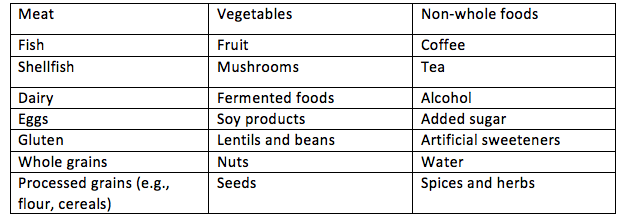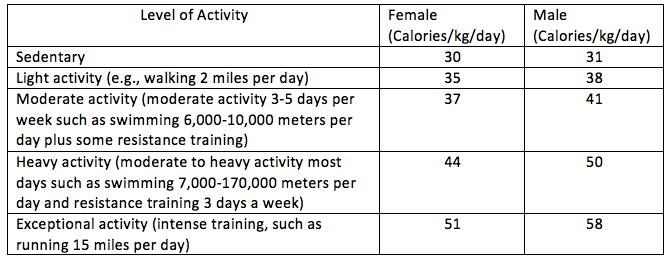DIY Dieting
How to create a diet that will work for you
Are you tired of trying to follow the latest diet? Are you feeling ravenous, losing energy and momentum but not losing anywhere near the weight/bodyfat you expected to lose?
If you are willing to try a different approach that would be tailored by you and for you, it may be time for a DIY diet. A DIY Diet is a diet that you design, based on your specific goals, circumstances and your personal preferences.
To design the diet, you begin as you would with any other diet: consult one or more resources. Webcasts, podcasts, articles and books as well as e-mails you receive through subscribing to various health-oriented websites. If you’re unsure where to start, try this website which acts in part as a kind of a concierge service, introducing you via to a variety of nutrition-oriented resources and their events. Use those resources to figure out what you want your diet to look like rather than in search of directions on what to eat.
In a DIY diet, usually you will pick a diet approach (vegan, ketogenic, low carb/high fat, etc) and then tailor the diet just for you. You will be able to do this because in creating your DIY diet, you will develop both an understanding of why you’re choosing a particular approach, and a knowledge of the key elements of that approach. As a result, you can discard the elements of that diet approach that are not critical or attractive to you and replace them with choices that you prefer and that will further your goals.
Sure, DIY dieting is a challenge in some ways, but it is also a huge opportunity to break free from restrictions inherent in standardized diets that you don’t understand, don’t like and maybe don’t need because they aren’t critical (or perhaps even relevant) to your success.
Here’s how it works. The first three steps involve making three high level decisions about your diet. The last three steps involve determining precisely what and how much you will eat of each item and creating suitable meal plans.
Three Initial Decisions
For the most part, a really good DIY diet (or any effective diet, for that matter) is going to involve minimizing eating out and emphasizing homemade meals.
You’re going to have to make three key decisions about your diet: the specific concerns, if any, that it will address; any foods that must or must not be part of the diet; and, with the above two decisions in mind, the main components of the diet.
1. Determining any Specific Health Issues to be Addressed
Decide if there are any specific conditions you would like your diet to address. Diet has implications for most health conditions, so presumably you’d like a diet that addresses your current concerns or minimizes the risk of developing one or more future health challenges. Conditions like chronic inflammation, allergies, long-term health, diabetes, heart disease and cancer may all be exacerbated by the wrong diet choices, and relieved, to some extent, by the right diet. If any of these are relevant, consult one or more resources that proposes a dietary approach to addressing it.
2. Identify any Specific Inclusions/Exclusions from the Diet
Determine if, no matter how much benefit it provides, there is any food that you absolutely will not eat or will not eat more than once within a specified period of time (e.g. once a week). Also, decide if there is any food you absolutely will not give up, even if it aggravates existing health problems or is highly likely to lead to health issues.
Be more than reasonable here. You may not like broccoli, but if broccoli is a superfood that substantially reduces your risk of inflammation would you exclude it from your diet? Even if several members of your family have suffered from debilitating autoimmune diseases and you consider yourself to be at risk for a similar fate? Similarly, you may love breakfast sandwiches, but if you fear cancer, perhaps you would be willing to concede that processed meats like bacon should not be part of your daily diet. Especially with information from the World Health Organization’s report which concluded that eating 50 grams of processed meat every day increases the risk of colorectal cancer by 18 percent.
3. Select the Main Components of the Diet
Weight loss is simply a matter of ingesting approximately 500–1000 calories a day below the level you would need to maintain your ideal weight. This can be achieved on any diet. The diet that is optimal for your purposes is the one that addresses your goals and doesn’t leave you ravenous or so uninspired by your food options that you feel compelled to cheat.
Perform research and select the main aspects of the diet that will work for you. This research can take the form of podcasts/webcasts, email articles, documentaries and books.
Consider that some diets are better than others for specific goals. Some elements of a diet have been proven effective, and other elements may only have anecdotal of improvements as a result of eating certain foods.
Modified plant-based diets are often found to be beneficial for minimizing cancer risk and for managing cancer. In this regard, some advisers, including Chris Wark, recommend very high intakes of particular vegetables and/or herbs to provide maximum benefit for those with cancer and to support the immune systems of people undergoing chemotherapy or radiation. Maybe you’ll decide you want to implement some anecdotal advice for a while a see if it works. Maybe you’ll decide your diet will be based solely on scientifically proven information.
People with allergies often find that specific foods can exacerbate their allergies (e.g., watermelon and ragweed). If that is a concern, you will need to be particularly deliberate in selecting your foods.
The keto diet has been found to be suitable for managing epileptic seizures in children and Dr. Terry Wahls has reported that a modified keto diet works well in managing/improving the health of patients with autoimmune diseases, particularly multiple sclerosis. Conversely, other experts, like Dr. Neal Barnard, report that plant-based (or plant-exclusive) diets are often found to be better for reducing inflammation and therefore helpful for conditions like autoimmune diseases. Other experts have found that the keto diet has significant adverse implications for gut bacteria.
Proponents of a healthy, no-sugar-added, whole foods vegan diet have reported that such diets eliminate the need to carefully monitor calories because people on these diets just naturally stop eating at the right caloric intake. Amazing, right?! At least one study appears to support this assertion.
These are the sorts of views you will want to weigh (no pun intended) before selecting your particular diet style and food choices.
Once you have chosen a basic diet approach such as vegan, keto or Mediterranean, you will need to determine the key components of your diet. Aside from the specific inclusions/exclusions you identified in 2, which of the following items will you consume regularly or exclusively, and within each category are there any items you will exclude? Maybe you will decide that you will eat salmon and halibut but not tuna.

Another design component involves the choices you will make with regard to purchasing and preparing your foods. Here are some to consider:
1. Whether you will buy organic food as much as possible
2. Whether you will juice some foods, in some instances (removes fiber but facilitates a higher daily consumption of nutrients from vegetables in many instances, due to the volume of vegetables juiced)
3. Whether you will only eat raw food
4. Whether you will prepare all foods for maximum nutrient release and absorption (e.g. pureed, cooked carrots release up to 3x the nutrients of raw carrots but maybe you don’t want to always eat carrots this way)
5. Whether you will add supplements where the diet is lacking or whether you would prefer to identify new foods to provide the missing nutrition (e.g., vegan diets are frequently low in vitamin B12 but daily requirements for vitamin B12 can often be obtained from approximately 2 tablespoons of nutritional yeast)
How to Determine How Much, and Precisely What, You Will Eat
4. Determine Your Daily Caloric Intake
Finally, you need to determine the number of calories you will ingest each day. The following estimates are used to calculate the calories required for a healthy adult to maintain his/her bodyweight:

The only subjective factor in the calculation is how active you are. If you’re trying to lose weight, be honest, and if you can’t decide just how active you are, pick the lower of the two levels you think might describe you. If you’re aiming to lose weight, aim for 1–2 pounds per week. This means lowering your caloric intake by 500–1000 calories a day, with an added caution that generally, caloric intake needs to be at least 1200 calories per day for adequate nutrition.
A food tracker app like Cronometer can help you determine whether the diet you have designed has adequate nutrition at a specific calorie level. Any weight loss greater than 1–2 pounds per week on a regular basis puts you at risk of compromising your health and your long-term weight objectives. If you use the estimated calories per kg/day above and find after a few weeks that you are consistently losing weight too fast, you can always bump up your calories slightly to address this concern. Similarly, if you are not losing weight (and not cheating), you might re-evaluate whether your activity level is actually lower than you originally believed.
Decide on the total calories you want to eat in protein, carbohydrates and fat. Generally, protein and fat intake should each be between 10– 35 percent of total calories, and carbohydrates should make up the remaining 30–80 percent of your total calories. Protein and carbohydrates each account for 4 calories per gram of food. Fat accounts for 9 calories per gram of food and alcohol accounts for 7 calories per gram of food. Here’s how those calculations work for someone with a total calorie goal of 1600 calories:

Try and allocate your calories for protein, fat and carbohydrates more-or-less equally to each meal.
Once you have chosen your diet strategy and determined your caloric intake, start putting together a meal plan. Choose whole foods that are nutrient dense food whenever possible. A food tracker app that monitors nutrients, and if you’re a vegan/vegetarian, essential amino acids, is a great idea.
5. Create Your Meal Plans
To safeguard your ability to eat according to your diet, you should identify precisely what foods you will eat at each meal and how much. A food tracker app is invaluable for this step.
(i) Standard Meal Options for Each Meal (3–5)
For each meal (breakfast, lunch, dinner), the total nutrient profile and calorie count of each option should be relatively similar so that the meals can be used interchangeably.
Why 3–5 choices for each meal? Because there is a lot left to be understood about nutrition and the body, and there are few if any foods that should be consumed on a daily basis. Even spinach, blueberries, and quinoa, all of which have plenty of health benefits, have a downside. These foods all contain relatively high levels of oxalates which, for certain people, can cause kidney stones. Therefore, it is a great idea to build variety into your diet to ensure you ingest a variety of nutrients, and do not ingest mega doses of any one food, as doing so might have adverse implications.
For example, a gluten-free vegan might consider the following breakfast options, all of which have relatively similar nutrient profiles:
- Quinoa and blueberries
- Amaranth and sweet cherries
- Oatmeal (find a gluten free option) and raspberries
Ideally, the dieter would have the frozen fruit in the freezer and the grains in a drawer. Breakfast would take approximately 10 minutes to make on any given day, with no one option being consumed more than three times in seven days.
(ii). Last-Minute Meal Options
Some last-minute meals options should be available in the house at all times, regardless of when you last went grocery shopping
Why? Because it is daunting to either wake up or come home hungry with no idea what you are going to eat.
Planning should be done in advance, and three to five options of last minute meals should be prepared and frozen for days when there is no standard meal option available, either because life got in the way or you are simply far too tired to spend much time preparing a meal. Frozen meals should be made in single servings in containers to make defrosting and reheating as quick as possible.
What last minute option might you put in your freezer or cupboard? Chilli, soup and stew can all be made in ways that can suit a range of diets from vegan to keto. Protein bars and ingredients for smoothies can also be kept available for quick meal options that involve little or no prep time.
(iii). Snacks Within the Diet Parameters
You should ensure you have snacks available at home, work and in your car/purse for non-meal times when you’re hungry.
Why? Any sensible diet will be rich in nutrient dense foods and low/void in junk food. Ideally, there will be no non-diet worthy food in the house, or if there is, it will not be accessible to you. If you arrange your circumstances in this manner, then you will have to go to the store when the urge to cheat hits, do without and perhaps obsess about the desire for non-diet food to the point of distraction, or be satisfied with the readily available and pre-approved alternative. Obviously, the latter approach is the one you want to adopt.
What might a pre-approved alternative be? Depending on your diet, any and all of the following might work:
- fermented foods (e.g., kimchi, sauerkraut, coleslaw, fermented pickles, yogurt with active bacterial cultures)
- edamame
- raisins
- raw fruit
- hummus / guacamole and veggies
- raw nuts or seeds
- protein bars
- smoothies made with frozen fruit and almond, coconut or real milk
- nori
- air popped popcorn
The DIY diet approach gives you a level of freedom, control and ownership that does not exist in a formulaic diet. Give it a try. With a little planning, it’s a great way to ramp up your enjoyment of eating as well as your health.










